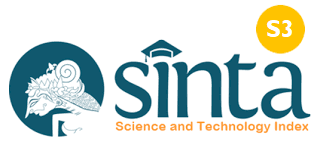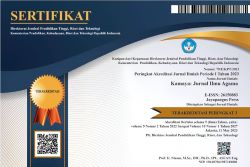Ideologi Penggunaan Ketupat Krosok dalam Upacara Yadnya Umat Hindu (Studi Di Desa Bengkel Kecamatan Kediri Kabupaten Tabanan)
DOI:
https://doi.org/10.37329/kamaya.v3i2.441Keywords:
Idiology; Ketupat Krosok; and Yadnya CeremonyAbstract
Ketupat has an important function and meaning for the life of the Hindu community, especially in Bengkel Village, Kediri District, Tabanan Regency both in social and ritual aspects. The connotation of the diamond for the community for the means of the ceremony is the matting of coconut leaves which is filled with rice and then boiled until cooked like rice. But Bengkel Village, Kediri Subdistrict, Tabanan Regency also uses krosok ketupat for its yadnya ceremony, which is ketupat which contains half-cooked and dry rice. This research uses a qualitative approach, which is sourced from primary and secondary data. Collected with techniques: observation, interview, and document study. The use of krosok ketupat for the community in Bengkel Village, Kediri Subdistrict, Tabanan Regency is based on the existence of ideology as the principle of understanding the modernity of the community which is implemented through applying but not deviating from the teachings of Hinduism. The reason why the ketupat ketupat was used in the Yadnya ceremony was because of practical and economic considerations, buying cheaper than the process of making it, and was easily available at any time. The religious implications of using ketupat krosok for the people of Bengkel Village, Kediri District, Tabanan Regency, that the community's confidence in carrying out the ceremony of Yadnya did not recede and instead became more enthusiastic. The economic implication is that people who carry out their yad ceremonies are economically able to carry out their obligations to work with income that is more profitable than setting aside special time to make a diamond by leaving time to work. While the ideological implications, that the Bengkel Village community, Kediri Subdistrict, Tabanan Regency, in the era of globalization in carrying out religious ceremonial obligations show the existence of a simplicative idea of the use of diamonds. The use of ketupat in some forms of banten is simplified to become ketapap krosok, especially in banten when it is finished not to be diluted / thrown.
References
Ardika, I. W. (2008). Pariwisata dan Komodifikasi Kebudayaan Bali. Dalam Pusaka Budaya dan Nilai-Nilai Religiusitas. Denpasar: Jurusan Arkeologi Fakultas Sastra Universitas Udayana.
Atmadja, N. B. (2010). Bali pada Era Globalisasi Pulau Seribu Pura Tidak Seindah Penampilannya. Yogyakarta: LkiS.
Atmaja, N. B. (2009). Pelampiasan Syahwat Kekuasaan dan Ngutang Gae, Ngalih Gae: Pemahaman Elite Parpol dan Akar Rumput terhadap Pesta Demokrasi (Pilkada, Pilgub) di Bali dari Denotasi ke Ideologi. Makalah disampaikan dalam Seminar di Denpasar. Denpasar.
Koentjaraningrat. (1992). Pengantar Antropologi. Jakarta: Renika Cipta.
Lubis, A. Y. (2006). Dekonstruksi Epistemologi Modern: dari Posmodernisme, Teori Kritis, Poskolonialisme hingga Cultural Studies. Jakarta: Pustaka Indonesia Satu.
Mangunwijaya, Y. (1982). Sastra dan Religious. Jakarta: Sinar Harapan.
Picard, M. (2006). Pariwisata Budaya dan Budaya Parwisata. Penerjemah Jean Couteau dan Warih Wisatsana. Jakarta: Kepustakaan Populer Gramedia- Forum Jakarta-Paris, Ecols Francaise d’extreme-orient.
Pitana, I. G. (1994). Mosaik Masyarakat dan Kebudayaan Bali. Denpasar: BP.
Sudibya, I. G. (1994). Hindu Menjawab Dinamika Zaman. Denpasar: BP.
Sujana, N. N. (1994). Kompleksitas dan Dinamika di Tengah Bangunan Kebudayaan Bali. Denpasar: Bali Post.
Sztompka, P. (2007). Soiologi Perubahan Sosial (Alimandan, Ed.). Jakarta: Media Group.
Triguna, Ida Bagus Gde Yudha. (2004). Kecenderungan Perubahan Karakter Orang Bali dalam Politik Kebudayaan dan Identitas Etnik. Ardika I Wayan dan Darma Putra, Nyoman editor. Denpasar: Fakultas Sastra Universitas Udayana. dan Balimangsi Press.
Triguna, Ida Bagus Gede Yudha. (1994). Pergeseran dalam Pelaksanaan Agama:Menuju Tattwa. Dalam Dinamika Masyarakat dan Kebudayaan Bali (I. G. Pitana, Ed.). Denpasar: Bali Post.
Tuner, B. (1990). Max Weber : From History to Modernity. London: Roulegne.
Wiana, I. K. (2006). Berbisnis Menurut Agama Hindu. Surabaya: Paramita.
Downloads
Published
How to Cite
Issue
Section
License
An author who publishes in the Kamaya : Jurnal Ilmu Agama agrees to the following terms:
- Author retains the copyright and grants the journal the right of first publication of the work simultaneously licensed under the Creative Commons Attribution-ShareAlike 4.0 License that allows others to share the work with an acknowledgement of the work's authorship and initial publication in this journal
- Author is able to enter into separate, additional contractual arrangements for the non-exclusive distribution of the journal's published version of the work (e.g., post it to an institutional repository or publish it in a book) with the acknowledgement of its initial publication in this journal.
- Author is permitted and encouraged to post his/her work online (e.g., in institutional repositories or on their website) prior to and during the submission process, as it can lead to productive exchanges, as well as earlier and greater citation of the published work (See The Effect of Open Access).
Read more about the Creative Commons Attribution-ShareAlike 4.0 Licence here: https://creativecommons.org/licenses/by-sa/4.0/.





